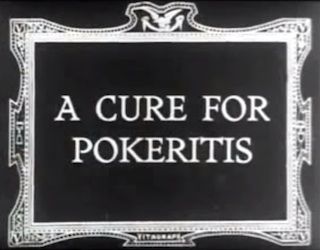Poker & Pop Culture: Prescribing "A Cure for Pokeritis"

In our short survey of cultural representations of early poker clubs, we've discussed actual clubs like The Thanatopsis Pleasure and Inside Straight Club and fictional ones like The Thompson Street Poker Club. Today we'll round out this topic with another early depiction of a poker club, the one portrayed in what is in fact one of the earliest "poker movies" ever made.
That's right �� there were poker clubs in the movies even before Rounders. Like way, way before.
Recognition for an Early Poker Movie
At the end of each year, the Library of Congress announces an annual list of films to be preserved as part of something called the National Film Registry. Among the selections made in 2011, a film was chosen that is arguably the oldest "poker movie" ever made �� a 12-minute silent short titled A Cure for Pokeritis first released over a century ago on February 17, 1912.
For a film to be chosen for the National Film Registry is kind of a big deal. The process for selecting films begins with the National Film Preservation Board and the general public compiling a list of candidates to be added. Then whoever is serving as the current Librarian of Congress personally selects from the list 25 films for inclusion.
Since 1989 there have been 25 films selected every year to be added to the National Film Registry, all chosen for their "enduring significance to American culture." When announcing the list in 2011, James H. Billington �� Librarian of Congress at the time �� described the National Film Registry as "a celebration of America�� in all its variegated richness."
Each year's list typically includes a wide variety of features and shorts, including both mainstream fare as well as more obscure titles. Thus does one find everything from The Wizard of Oz to The Exorcist to The Muppet Movie to the Zapruder film of the JFK assassination among the films included. The year A Cure for Pokeritis was chosen, there was yet another eclectic bunch that included both Bambi and Silence of the Lambs.
A Cure for Pokeritis wasn't the first film involving poker to have been selected for preservation. In 2005, both Cool Hand Luke (1967) and The Sting (1973) were chosen, two films which each include highly memorable poker scenes.
That said, A Cure for Pokeritis is most certainly the only "poker movie" to have been chosen for the National Film Registry thus far. Besides giving us a glimpse of early poker clubs, the film is also an interesting document of the place and significance of poker in American culture during the early 20th century.
A Refuge for Card-Playing Husbands: The Poker Club
While the selection of A Cure for Pokeritis for the National Film Registry helps bolster the case for poker's prominence in American culture, the choice was mostly made thanks to the starring turn of the comic actor John Bunny. Bunny appeared in more than 150 silent films, making the rotund comedian one of America's most important early film stars and a national celebrity prior to his untimely death in 1915.

A number of Bunny's films saw him playing the role of a henpecked husband, often appearing opposite Flora Finch as one of cinema's first comedy teams. A Cure for Pokeritis, directed by Laurence Trimble for Vitagraph, typifies that formula, pitting the two against one another with poker being the wedge that divides a married couple.
An initial title card explains the opening scene: "A game of poker. Loser again."
We watch the round-faced Bunny playing the role of George Brown, putting on hat and jacket as he leaves a smoke-filled poker game. He's having to borrow money from another player before he exits just to cover the fare home. He returns late, endures a berating from his wife Mary (Finch), and tries to smooth things over by swearing to her he'll never play poker again.
A week passes, and George receives an invite to be initiated into the "Sons of the Morning," a men's lodge that meets every Wednesday night. According to the terms of the lodge, failure to appear incurs a fee of ten dollars, thus giving Mary no choice but to agree to her husband's participation.
Of course it's all a ruse �� the "Sons of the Morning" is just a cover for the same weekly poker game at the club where Brown had been playing before.
The plan works until George starts talking in his sleep, giving away his secret to his wife. She then recruits strait-laced Cousin Freddie to help with her plight, and he in turn recruits his Bible club to help him out.
Soon Cousin Freddie and Mary's plotting involves more wives who are also angry about their poker-playing husbands, and they all have "an indignation meeting" with Freddie during which a plan is finalized. Freddie and the other Bible club members then dress up as policemen and with the wives in tow conduct a faux raid on George's poker game.
Fears of arrest soon dissolve into animated expressions of relief among the players, with George and Mary's film-ending embrace apparently signaling his having once and for all agreed to stop playing poker.
Here's the complete film, if you're curious. The soundtrack has been added, and it does add to the generally light mood of the story:
Presenting Poker as an Illness in Need of a Cure
Besides highlighting the general prominence of poker at the time, A Cure for Pokeritis reminds us of a few different cultural significances of poker from a hundred years ago.
As noted, the film does present us a glimpse of the poker club, here presented a way for George to enjoy poker along with other men apparently also not allowed to play cards at home. It's a safer environment than the Old West saloons and gambling dens of the previous century, although as the pretend police raid at the end of the film implies, still potentially risky if the games aren't legally sanctioned.
The film also helps indicate how by the early 20th century poker had fully entered the "domestic sphere" �� that is, it had moved from the saloons and steamboats into homes and (in this case) clubs. No longer a game just for card sharps and cheats, poker had made its way into the living rooms of all classes, a move similarly indicated by Cassius M. Coolidge's famous "Dogs Playing Poker" series of paintings from 1903.
Also like in Coolidge's paintings �� in which only male dogs play (while female dogs occasionally watch) �� the cigar-chomping, masculine culture of poker is on display in A Cure for Pokeritis as well.
One other idea �� suggested both by the film's title and its plot �� is that poker represents a kind of disease or illness in need of curing. With the temperance movement in full swing (the Volstead Act and start of prohibition would come just a few years later), poker and gambling were associated with other vices thought by many in need of being remedied, and the film comically shows a "cure" being successfully prescribed.
In other words, while some celebrated poker clubs, others saw them as detrimental to American society �� a conflict that gets played out in cultural productions of the period.
Another Candidate for "First Poker Movie"
We'll be discussing poker in the movies a lot more down the road in this series, but with this mention of A Cure for Pokeritis it is worth noting one other even earlier film featuring the world's favorite card game �� a challenger for the title of "oldest poker movie."
It's called The Last Deal and was written and directed in 1910 for Biograph by the pioneering director D.W. Griffith (best known for the controversial Birth of a Nation, Intolerance, and other titles). Running about 11 minutes, it tells a story not unlike the one in A Cure for Pokeritis, although in more of a dramatic than comic vein.
The Last Deal similarly presents poker and gambling as a kind of illness. A character is introduced as an addict whose poker-playing threatens to lose him his job and family until his brother-in-law comes along to help him with his "gambling fever." There's also a classic (or clich��d) four-aces-versus-four-kings hand in there, too.
The Last Deal stars Owen Moore who appears in a lot of Griffith productions and was secretly married to Mary Pickford with whom he appeared in several films. Unfortunately, The Last Deal film is not readily available online, although unlike other early silent films copies do still exist.
In any case, A Cure for Pokeritis definitely gets the nod as the first significant film to highlight poker in its plot, with its being added to the National Film Registry giving it a further stamp of approval as a significant contribution to American culture.
And like Rounders would do at the end of the 20th century, A Cure for Pokeritis also helps show poker's complicated place within American culture �� loved by many, literally thought a societal "ill" by others.
From the forthcoming "Poker & Pop Culture: Telling the Story of America��s Favorite Card Game." Martin Harris teaches a course in "Poker in American Film and Culture" in the American Studies program at UNC-Charlotte.









